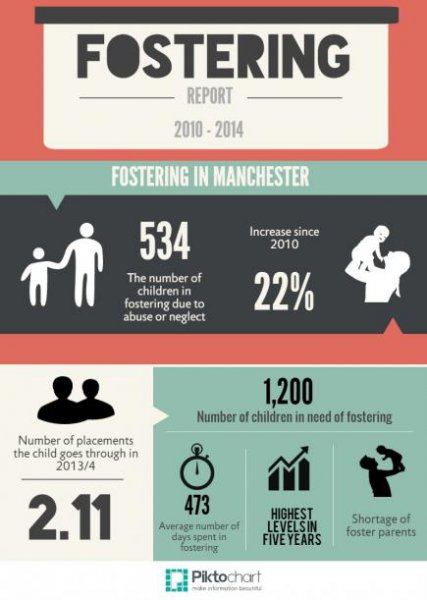Attracting and Keeping Carers - April 2015
Alongside our Why Foster Carers Care Part II, we also launched our second Local Authority Fostering Service benchmark report. The latest report, analysing data from 2013/14, provides an insightful statistical comparison with the first benchmark report. Headline findings show that around a third of placements are currently underutilised, and between two and 30 per cent of enquiries are on average progressing to approval. The report contains some key questions for all fostering services to consider.
March also brought to an end our pilot programme of fostering roadshows. During February and March The Fostering Network visited eight towns and cities across England, providing presentations and workshops on a range of subjects to members of The Fostering Network. Bringing foster carers and members of the fostering service together has been encouraging, with overwhelmingly positive initial feedback. If you missed the last series, make sure you catch the next.
Looking ahead, we’re in the planning stage for our next benchmark survey. Register your interest in participating or ask further questions by contacting me: james.foyle@fostering.net
Planning for Foster Care Fortnight™ is also well underway – more on that and other news below…
Foster Care Fortnight™ update
From giant jigsaws to fostering fiestas, I’ve been hearing some exciting plans for this Foster Care Fortnight™.
With this year’s overarching Fostering, make a connection theme, services have been able to weave ideas into their current campaigns or set plans in place to start something spectacular from scratch.
To help you on your way, the My Connection to Fostering placard can be used at events or on stands or stalls to engage people in thinking about what fostering means to them, and how they are connected. Their pictures can then be posted on your social media channels to join in with the national campaign.
Take a look at some of the other ideas for how you can use this year’s theme in your guide to getting involved.
Our fostering family
Sons and daughters of foster carers in Stockton on Tees have been expressing their thoughts and feelings about what it’s like to foster through a cartoon.
The children, aged between 5 and 13 years old, have been working with Icelandic artist, Ingi Jensson, who has been making cartoons for over 15 years and has had his comics published in the UK and Scandinavia.
 As a group, the young foster carers thought up an imaginative story and characters for a cartoon strip about their experience of welcoming a child into their home and the adventures and challenges that this brings to a fostering family.
As a group, the young foster carers thought up an imaginative story and characters for a cartoon strip about their experience of welcoming a child into their home and the adventures and challenges that this brings to a fostering family.
Developing the cartoon was an extremely positive experience for the young people involved; Allysha, aged 8, was one who took part. She said: “I loved making the cartoon and Ingi was really funny when we were drawing the characters. I think fostering is one of the best things that a family can do to help other children. It gives me lots of children to play with, and I enjoy being a role model ‘big sister’ to them and making them laugh. When I’m older, I would like to be a foster carer myself.”
Sons and daughters play a vital role in the fostering family, and their experiences can help others in their position to understand fostering.
Emily’s Story
As Stockton demonstrates, involving care experienced young people in shaping resources designed for others like them can lead to highly positive outcomes.
Haringey Council have also been busy producing content for, and with, young people in care. Emily’s Story – a guide to foster care is a six minute film for children going, or who have recently gone, into foster care.
Developed with the support of Aspire, the service’s children in care council, the animation ‘explores life in foster care, what a carer actually does, the role of adult professionals providing additional support, entitlements, health, education and preparing for the future’.
The film looks to be targeted at younger children in tone, but does cover a range of topics that will benefit older children.
Although not created as a recruitment tool, this type of film could be extremely useful to prospective foster carers attending an information session to understand foster care from the viewpoint of a young person.
The Fostering Network has recently been awarded funds to help develop children in care councils in England and create more positive stories like Emily’s.
1,200 children in Manchester need fostering
 Local newspaper Mancunian Matters has recently performed a freedom of information request on Manchester Council’s fostering service to highlight the issues facing looked after children in the city.
Local newspaper Mancunian Matters has recently performed a freedom of information request on Manchester Council’s fostering service to highlight the issues facing looked after children in the city.
Their research has found an increase in the number of children coming into care due to domestic abuse, an increase in the average number of placement moves, and the impact that is having on the need for more foster carers.
Further into the article, the lead councillor comments, “What we don't really want is long-term fostering, because that's not stability for children.” Their view on statistics is also skewed with the line, “The idea is to help parents from birth and then support them to keep the children because children don't fare better in care - that's what statistics do show”.
I fundamentally disagree with their first point, and would argue the case on the second. I agree that early intervention with troubled families can have a positive impact, but this is not a guaranteed solution to prevent children coming into care. ‘Statistics’ may refer to outcomes for children in care against the overall population. In Loco Parentis, the report by Demos, is a useful reminder of the myriad factors impacting on looked after children, as well as the importance of stability in care, which can be achieved through long-term fostering.
IN FOCUS – national practice developments
This month’s IN FOCUS takes a look at some of the recent national developments in practice, which will influence your services foster carer recruitment and retention initiatives.
New after care provisions in Scotland
The Fostering Network Scotland is delighted that from 1 April, children in foster care in Scotland will have the right to remain living with their foster carers until the age of 21, as the aftercare provisions of the Children and Young People Act 2014 come into force. This new duty for Scottish local authorities was achieved thanks to many years of campaigning by The Fostering Network, including our successful Don’t Move Me campaign, and others.
Care Planning and Fostering (Miscellaneous Amendments) Regulations 2015
The Care Planning and Fostering (Miscellaneous Amendments) Regulations 2015 came into force on 1 April 2015.
Amendments are made to the Children Act 1989 Guidance: Care Planning, Placement and Case Review (Volume 2) in order that:
- foster carers and residential child care workers are appropriately consulted and involved in decision making for children;
- where the plan for permanence is long-term foster care there is an appropriate planning process which considers the needs of the child and the capacity of the carer to meet these needs;
- where a long-term foster placement is agreed this is recorded in a child’s placement plan; and that appropriate and flexible visiting and case review arrangements are made;
- where a local authority, in consultation with the child and their family, is considering ceasing to look after a child, the authority appropriately assesses the proposed arrangements for the child and sets out the support that will be provided when the child ceases to be looked-after;
- the authority consults appropriately with the child, their parents and others to ensure that the proposed arrangements are in the child’s best interests and will safeguard and promote their welfare; and
- the authority has robust arrangements in place to scrutinise decisions to cease to look after a child.
Download the statutory guidance for Permanence, long-term foster placements and ceasing to look after a child
The Children Act 1989: Vol 3 Planning Transition to Adulthood for Care Leavers (revised Jan 2015)
The following amendment has been made in the current version of this guidance;
- 7:12 updates what is suitable accommodation and states that bed and breakfast is to be used only in exceptional circumstances and for not more than two days
Revised guidance is available.
NCB Online Survey - Reviewing the initial impact and implementation of Staying Put
The National Children’s Bureau (NCB), as part of the Children’s Partnership, had a good response (500 in total) to their online survey looking at the initial impact and implementation of the staying put legislation in England.
A seminar on 10 February 2015 discussed the findings from the research under three main headlines with senior Department for Education officials and considered what further steps might be needed to ensure that Staying Put is successful.
The three headlines are:
- Support issues – use of SGOs, agreements to the end of a young person’s educational year at 18 and where should support come from
- Barriers – overall funding, rates of payment, sufficiency – a concern which has not been evidenced to date, family and friends carers lose housing benefit
- Enablers – Foster carers are unclear about continuing to be registered. Clarity is needed that they can remain registered even without a room available. To be raised with OFSTED.
We hope to be able to share further updates next month.
‘New burden’ funding allocation for staying put survey
The ADCS has conducted a brief survey of its members in respect of the “new burdens” funding allocation for 2014/15 - the allocation of funding in respect of staying put to all 153 local authorities in England. From the 46 which provided specific figures (all rounded to nearest £500):
- £2,189,000 has been allocated by the Government in new burdens funding for this year
- £6,085,000 has already been committed by local authorities for arrangements in place now
- This represented a shortfall already at the time of the survey (five months into the policy) of £3,896,000. If this sample of a third (of LAs and of allocated new burdens funding) were extrapolated, based on the total £7,400,000 allocated to all LAs by government, it would suggest a shortfall across the country, already, of over £13,000,000.
The ADCS wrote to the minister before Christmas advising of the serious shortfall in funding. Edward Timpson has responded to them to reaffirm the Government’s commitment to staying put, however he feels it is too early to predict the cost of the programme. He states that the DfE will continue to monitor the take-up of staying put and review how the programme is being implemented.
New guidance on Disqualification by Association
The DfE has issued new guidance in respect of “disqualification by association” as it relates to all schools. The statutory guidance is for local authorities, school leaders, school staff and governing bodies in England.
In respect of foster carers, the only statutory requirement under Fostering Services (England) Regulations 2011 and 2013 is in Schedule 3(13). This requires that the foster carers and all members of their household who are 18 or over have an enhanced criminal records check (DBS) undertaken. As there is no further legal requirement in fostering regulations as to how often these DBS checks are undertaken, the onus would be on the local authority placing any looked after child with foster carers to disclose any relevant caution or conviction prior to the placement planning meeting.
AND
Guidance published by the NDNA Staff Suitability and Disqualification Factsheet – England’ states on page 4 under ‘Best Practice Tip’ that even if a foster carer was living with a young adult who is disqualified and therefore disqualified from working with children by association, there are two points to bear in mind:
“Firstly, the person is not guilty of an offence if they do not know a person they are living with is disqualified. For example, a member of staff may live in shared housing and may not have any knowledge about the people they live with including whether those people are disqualified. Neither the member of staff nor the provider has any legal requirement to seek this type of information.
"Secondly, the law is clear that this is ab out ‘knowingly employing’ someone who is disqualified. Providers who regularly ask staff to confirm there are no changes in their circumstances and act on any information received that brings into doubt a staff member’s suitability are taking appropriate steps to make sure they do not knowingly employ someone who is disqualified.”
Finally, if such a situation were to happen, then there would still be the option for the foster carer of obtaining a waiver from Ofsted as outlined in your attached Department for Education ‘Keeping children safe in education - supplementary advice’.
PS
From Italy, a modern European appeal for foster carers…





